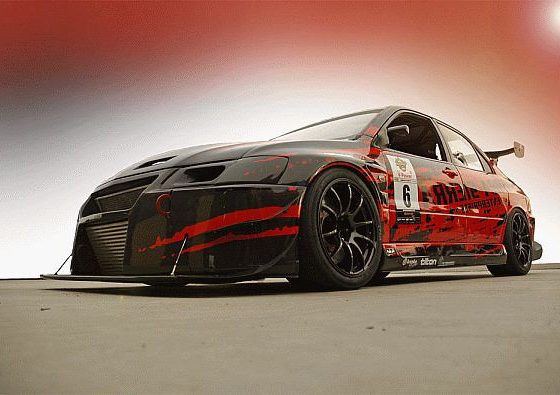
The Best-Engineered Cars of Lemons
#2 – the MetroGnome
You think the big story here is sportbike power in a Geo Metro, but you're wrong. The big story is the countless details to make it work, the clever application of junkyard suspension technology and, oh yea, escalation. Just when things were starting to look sorted, the engine moved to the back…
But lets start at the beginning: We first stumbled into Alex Vendler and Colin Drobnis testing the MetroGnome at least a month before we finished the FrankenMiata. The very fact that these guys were on a track sorting things out three months before their first race showed an intimidating level of preparedness. Less intimidating was the car itself.
 | |
| This is how we found it, innocently disguized as a Geo Metro, wearing goofy junkyard wheels (free genius points for the first person who can identify the donor car). The only hint was an oddly-positioned stack of air filters poking from the engine bay. Well, that and the otherworldy F1 soundtrack… |
Stuffing a Honda CBR900 engine in a Geo Metro is one of those things that sounds like a really good idea when you're drunk, but loses some luster on hangover day.
Modern sportbikes pack amazing race engine technology into convenient packages you can buy for a few hundred bucks (after some squid drops it, naturally). Their specific output is astounding and they make sounds to die for, but relax that techno-boner a bit and the cold reality of their smallness slowly comes into focus. That 12,000 RPM screamer you're getting all hot and bothered over makes, what, 120 hp? You'd laugh at any car engine with that output, and the car would still destroy the sportbike's measly 4 lb-ft torque output.
No, a CBR-powered Metro should be faster than a Metro-powered Metro, but it won't exactly warp space and time. A stock Metro is a shocking bantamweight, though, hanging around in the 1,600-lb neighborhood. That should make the power-to-weight ratio pretty similar to our 144-hp, 2,000-lb FrankenMiata. Serious competition perhaps, if they could make it handle.
Making it fit
 | |
| The chain drive setup requires the whole engine/transmission assembly to sit several inches forward of the differential, placing the engine awkwardly far forward in the car. Luckily, the whole thing only weighs 160 lbs, so weight distribution isn't as bad as you would expect. That's the stock Metro radiator sucking air through the headlight socket. |
Bike-powered cars are tricky to build because of the way bikes are packaged. Engine and transmission are packaged together in one case, so you can't use the car's transmission. Using the bike's built-in transmission is fine, but there's no final drive, since the chain and the big sprocket on the rear wheel serves that duty, and of course, there's no differential on a 1-wheel drive bike.
For such a complicated problem, Alex and Colin had a fantastically simple solution. They tore down the Metro's transmission, removed the differential, took the ring gear off it, and replaced it with a sprocket. Next, they took the bearings off the diff and replaced them with sealed bearings that don't require a bath of gear oil to survive. They then built a crude angle-iron subframe to hold the diff in its original position in the car, but without that silly transmission around it.
The conversion was now a simple matter of sticking the bike engine in front of the stock diff and axles, and running a very short chain between them.
Simple indeed.
 | |
| Alex and Colin using an “inertia press” to remove their welded diff from the sealed bearing/aluminum brick assembly that holds it in the car. |
It turns out there are two very good ways to shorten the life of a motorcycle chain. One is to pull around a 1600-lb car with it. The other is to make it short.
Each link in a chain goes through a cycle of flapping along lazily on the slack side, bending and sliding up against teeth to go around the rear sprocket, getting the living hell yanked out of it on the tight side, bending tighter and rubbing on more teeth on the tiny front sprocket, then returning to the lazy side. The shorter the chain, the faster this cycle repeats, and the more times each link has to rub up against a tooth. This bending, rubbing and stretching is what eats chains, and the Metro was showing quite an appetite.
The conundrum for the day was how to lube the chain enough that it would survive, without getting kicked off the track for pissing oil. Alex and Colin were weighing the options of letting a leaky bottle of motor oil drip on it while they drive, vs. mounting an aerosol can of chain lube in the car, with a long hose going through the firewall. I suggested simply mounting a giant novelty candle in the engine bay and letting it rub on the tight side of the chain. The friction would melt the wax, lubing the chain automatically. We all agreed an undertray lined with tampons should contain the mess. And with that, a bond of friendship was forged around a common sense of idiocy.
The other issue was lubricating the diff itself. Going straight, the spider gears in a diff don't move, so they don't need any lube. Have the audacity to turn, though, and you've got dry, dirty gears responsible for making your car go. God help you if you spin the inside tire.
Alex and Colin first tied grease, but it flung off immediately. They then tried a welded diff, which needs no lube at all, but the car wouldn't handle worth a crap. They finally settled on an open diff, with lots of grease and a toilet plunger to keep the slippery stuff inside.
After this chance meeting, we immediately made a chain guard for our car to protect our belts from the inevitable day when MetroGnome would shit its chain out right in front of us.
 | ||
| Before seeing the MetroGnome, you could see the Frankenmiata's crank pulley from this angle. Fear of an errant motorcycle chain prompted us to fasion this protective shield from an old hot water heater shed. Overly paranoid? Hardly. We almost lost our CRX's timing belt a few races earlier when a rearview mirror bounced off its cam sprocket. |
At the end of the day, a few things were certain. Alex and Colin were our kind of people, their car was clever, mechanically entertaining, and not slow, and we were going to clobber them with the Frankenmiata when both cars made their simultaneous debuts at the 2008 Arsefreezapalooza race at Thunderhill.
Well, we were mostly right. They were fast, they never threw a chain and they won convincingly on their first time out. The plunger did not survive.
Hit the next page to see how they made it handle.



